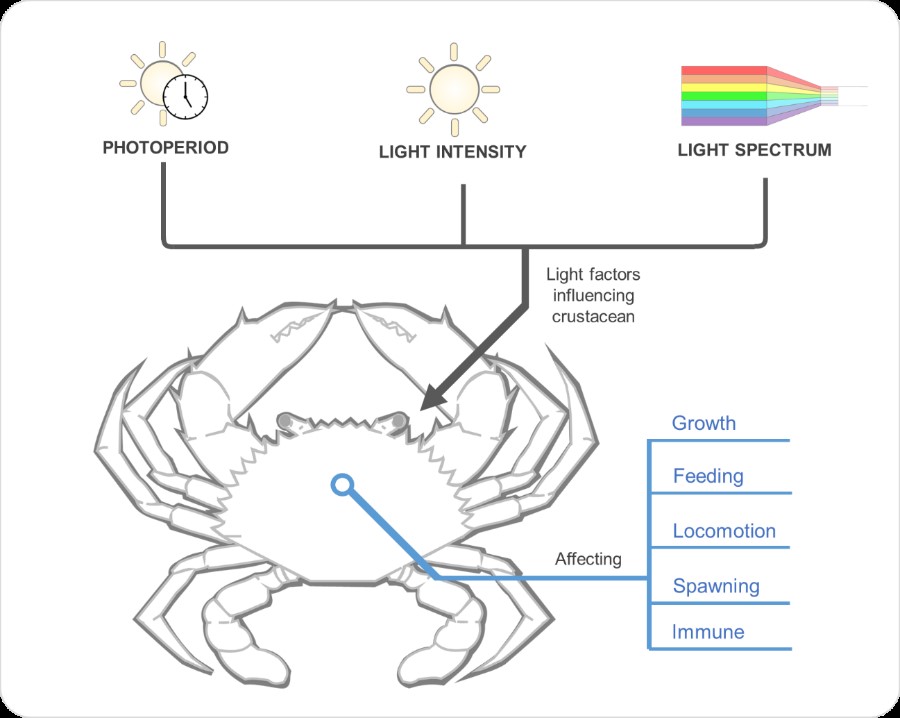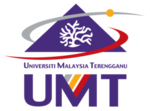ABIOTIC LIGHT FACTOR TOWARDS FUTURE CRUSTACEAN AQUAFARMING TECHNOLOGY IN PREPARING FOR GLOBAL CLIMATE CHANGE
Keywords:
Light, Photoperiod, Light Intensity, Light Spectrum, CrustaceanAbstract
The ramifications of light on crustacean circadian rhythm are complex and multifaceted since light has three core elements included of photoperiod, spectrum and intensity. Most marine crustacean has a planktonic larval phase in their life cycle before metamorphosing into benthic juvenile, this ontogenetic shift from a planktonic to a benthic life requires a different level of light photoperiod, spectrum and intensity. Hence, this review is planned on the basis of referring to a large number of accumulated scientific findings and further emphasizes the light impacts on the different life stages (larva, juvenile and adult) of crustaceans with myriad approaches in the areas of growth, feeding, locomotion, spawning and immunity. In terms of photoperiod, there is a high tendency of larval crustaceans to favour longer photoperiods (more than 18 L) during the early stage. Later, up to a certain extent, perhaps amid the juvenile stage, photoperiod preference shifted towards shorter photoperiods as such later juvenile stage demonstrated a pressing need for dark photoperiod reflected the common nocturnal behaviour in crustaceans. In terms of light intensity, several previous studies convinced that more light intensity is requisite as a vital need to enhance larval growth, as well as emphasized the positive impact of light intensity on ovarian progression in adult female crustaceans. For the context of the light spectrum, former evidence deciphered the benefit of utilizing white light in terms of survival, growth and reduced stress, as well as rising antioxidant capacity in the crustacean. Simultaneously, instead of the white spectrum, adopting green, blue and cyan light spectrums perhaps had a high potential to be incorporated into aqua-farming. As a whole, for future studies, many experts need to take the initiative to engage in upgrading further existing research by prioritizing light intensity and light spectrum to better understand the light repercussions on crustaceans. Regarding future applications, the breakthrough from this review fosters and advocates farmers and researchers to shift to an enclosed system set-up in terms of optimization of myriads' light approach, including photoperiod, light intensity and light spectrum, in tandem with such system is resilient against catastrophic global climate change. This light optimization during crustacean culture is a pivotal avenue to enhanced farming productivity and providing assurance of food security preservation for the sake of the next generation.
References
Andres, M., Rotllant, G., Zeng, C. (2010). Survival, development and growth of larvae of the blue swimmer crab, Portunus pelagicus, cultured under different photoperiod conditions. Aquaculture, 300(1-4),218–222. https://doi.org/10.1016/j.aquaculture.2009.12.026
Babita, P. S. (2019). Effect of environmental factors on the reproductionof marine crab, Portunus sanguinolentus. Indian Journal of Research, 8(3),59–61.
Bermudes, M., Ritar, A. J. (2008). Response of early-stage spiny lobster Jasus edwardsii phyllosoma larvae to changes in temperature and photoperiod. Aquaculture, 281(1-4),63–69. https://doi.org/10.1016/j.aquaculture.2008.05.035
Chen, S., Shi, C., Migaud, H., Song, C., Mu, C., Ye, Y., Wang, C., Ren, Z. (2022). Light spectrum impacts on growth, molting, and oxidative stress response of the mud crab Scylla paramamosain. Frontiers in Marine Science, 9. https://doi.org/10.3389/fmars.2022.840353
Chittleborough, R. (1975). Environmental factors affecting growth and survival of juvenile western rock lobsters Panulirus longipes (Milne-Edwards). Marine and Freshwater Research. 26(2),177. https://doi.org/10.1071/mf9750177
De los Santos-Romero, R., García-Guerrero, M., Vega-Villasante, F., Cortés-Jacinto, E., Nolasco-Soria, H. (2017). Effect of photoperiod and temperature on growth and activity of digestive enzymes in juveniles of the long-arm river shrimp Macrobrachium tenellum (Smith, 1871) (Caridea: Palaemonidae). Journal of Crustacean Biology. 37(4),445–452. https://doi.org/10.1093/jcbiol/rux055
Fitzgibbon, Q.P., Battaglene, S.C. (2012). Effect of photoperiod on the culture of early-stage phyllosoma and metamorphosis of spiny lobster (Sagmariasus verreauxi). Aquaculture, 368-369,48–54. https://doi.org/10.1016/j.aquaculture.2012.09.018
Hamasaki, K., Imai, H., Akiyama, N., Fukunaga, K. (2004). Ovarian development and induced oviposition of the overwintering swimming crab Portunus trituberculatus (Brachyura: Portunidae) reared in the laboratory. Fisheries Science. 70(6),988–995. https://doi.org/10.1111/j.1444-2906.2004.00898.x
Herrnkind, W., Kanciruk, P. (1978). Mass migration of spiny lobster, Panulirus argus (crustacea: palinuridae): Synopsis and orientation. Proceedings in Life Sciences. 430–439. https://doi.org/10.1007/978-3-662-11147-5_43
Huang, X., Ye, H., Huang, H., Yu, K., Huang, Y. (2014). Two beta-pigment-dispersing hormone (β-PDH) isoforms in the mud crab, Scylla paramamosain: Implication for regulation of ovarian maturation and a photoperiod-related daily rhythmicity. Animal Reproduction Science, 150(3-4), 139–147. https://doi.org/10.1016/j.anireprosci.2014.09.004
Ikhwanuddin, M., Salwani, A. N., Mohamad, S., Bolong, Abo. A. (2019). Growth and survival of blue swimming crab, Portunus pelagicus larvae at different photo period and light intensity. Asian Journal of Biological Sciences. 12(2), 199–203. https://doi.org/10.3923/ajbs.2019.199.203
Jaski, M. G., Kamrani, E., Salarzadeh, A. (2014). The study effect of sun light on growth performance and survival of postlarval white leg shrimp (Litopenaeus vannamei) and salinity stress resistance. European Journal of Experimental Biology. 4(2):7–12.
Kim, D. H., Kim, S. K., Choi, J. H., Kim, B. R., Seo, H. C., Jang, I. K. (2010). The effects of manipulating water temperature, photoperiod, and eyestalk ablation on gonad maturation of the swimming crab, Portunus trituberculatus. Crustaceana. 83(2),129–141. https://doi.org/10.1163/001121609x12591347509248
Lipcius, R.N., Herrnkind, W.F. (1987). Control and coordination of reproduction and molting in the spiny lobster Panulirus argus. Marine Biology. 96(2),207–214. https://doi.org/10.1007/bf00427020
Matsuda, H., Abe, F., Tanaka, S. (2012). Effect of photoperiod on metamorphosis from phyllosoma larvae to puerulus postlarvae in the Japanese spiny lobster Panulirus japonicus. Aquaculture. 326-329,136–140. https://doi.org/10.1016/j.aquaculture.2011.11.027
Morales, M. I., Barba, J. R. B. (2015). Effects of photoperiod, water levels and sex on the feeding efficiency and weight increment of Mudcrabs (Scylla serrata Forskall) in a crab-fattening culture system. International Journal of Fisheries and Aquatic Studies. 3(1),320–324.
Pervaiz, A. P., Madhu, S., Malabikar, S. (2015). Effect of photoperiod and temperature on gonadal development of freshwater prawn Macrobrachium Dayanum. Journal of Fisheries and Aquaculture. 6(2),191–195.
Ravi, R., Manisseri, M. K. (2013). The effect of different pH and photoperiod regimens on the survival rate and developmental period of the larvae of Portunus pelagicus (Decapoda, Brachyura, Portunidae). Iranian Journal of Fisheries Sciences. 12(2), 490–499.
Sachlikidis, N. G., Jones, C. M., Seymour, J. E. (2005). Reproductive cues in Panulirus ornatus. New Zealand Journal of Marine and Freshwater Research. 39(2), 305–310. https://doi.org/10.1080/00288330.2005.9517310
Sanudin, N., Tuzan, A. D., Yong, A. S. K. (2014). Feeding activity and growth performance of shrimp post larvae Litopenaeus vannamei under light and dark condition. Journal of Agricultural Science. 6(11). https://doi.org/10.5539/jas.v6n11p103
Tidwell, J. H., Coyle, S., Vanarnum, A., Bright, L. A., McCathy, M. (2001). The effect of photoperiod on growth and survival of juvenile freshwater prawn, Macrobrachium rosenbergiiin Nursery Tanks. Journal of Applied Aquaculture. 11(4):41–47. https://doi.org/10.1300/j028v11n04_04
Wang, X., Liu, B., Gao, X., Wang, X., Li, H., Xu, L., Wang, G., Zhao, K., Huang, B. (2021). The effects of different uva photoperiods on the growth performance, immune responses, antioxidant status and apoptosis-related gene expression of the pacific white shrimp (Penaeus vannamei). Antibiotics. 11(1):37. https://doi.org/10.3390/antibiotics11010037
Wei, J., Tian, L., Wang, Y., Yu, L., Zhu, X. (2021). Effects of salinity, photoperiod, and light spectrum on larval survival, growth, and related enzyme activities in the giant freshwater prawn, Macrobrachium rosenbergii. Aquaculture. 530, 735794. https://doi.org/10.1016/j.aquaculture.2020.735794
Withyachumnarnkul, B., Poolsanguan, B., Poolsanguan, W. (1990). Continuous darkness stimulates body growth of the juvenile giant freshwater prawn, Macrobrachium rosenbergii de Man. Chronobiology International. 7(2), 93–97. https://doi.org/10.3109/07420529009056960

Published
How to Cite
Issue
Section
License
Copyright (c) 2024 Planetary Sustainability

This work is licensed under a Creative Commons Attribution-ShareAlike 4.0 International License.




